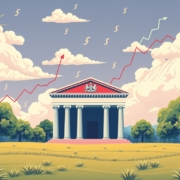Navigating the Storm: Ukraine’s Debt Sustainability Crisis Amid Accelerating IMF Talks
Ukrainian Debt Sustainability Challenges Persist Amid Accelerated IMF Programme Talks
By Dennis Shen, Updated September 29, 2025, 14:21 GMT
The conflict between Russia and Ukraine drags on into its fifth year. War pushes Ukraine into hard debt management and budget stress. Ukraine turns to frozen Russian funds and may alter its debt. Kyiv now talks with the IMF for new help.
Economic Growth and Fiscal Outlook
Scope Ratings shows that slow activity in early 2025 leads to weaker growth. Ukraine sees real GDP at 2.0% in 2025 and a slight rise to 2.25% in 2026. The budget gap stays wide at about 18.3% of GDP this year and 15.3% next year.
Debt climbs fast. End-2025 debt tops 95% of GDP, up from 91.2% at year-end 2024 and 49% in 2021. War spending and economic disruption keep debt on the rise.
The Impending IMF Programme and Financing Constraints
Ukraine runs an IMF Extended Fund Facility that gives USD 15.5 billion, set to end in March 2027. Kyiv now asks for a new four-year plan as war continues.
Military costs claim around 60% of the budget. This heavy use stops funds from flowing to pensions, public wages, and social aid. Ukraine now needs large sums from outside backers.
The IMF may support Ukraine only if debt stays manageable and repayment plans are set. War adds doubt and makes these checks tougher. Ukraine set goals to cut debt to 82% of GDP by 2028 and down to 65% by 2033. The long conflict now puts these targets at risk.
Funding Gap and the Role of Frozen Russian Assets
Scope Ratings and the IMF now see a need for nearly USD 65 billion more by 2027. This gap far exceeds Ukraine’s estimate of USD 38 billion.
Long-term, the budget gap may stick close to 20% of GDP each year, meaning about USD 50 billion must come each year from friends abroad. If US funds fall short, the EU may face more strain. The EU stands as Ukraine’s single largest funder even as it deals with its own limits.
Usual finance routes run nearly dry. The EU’s Macro-Financial Assistance+ and G-7 ERA loans (using cash from seized Russian assets) are nearly spent.
The European Commission now plans a new use of frozen Russian money. It will swap cash with short-term, zero-coupon EU bonds that keep Russian legal claims close. With this swap, Ukraine gets zero-interest “reparations” loans. These loans need to be repaid only if Russia stops fighting and later compensates Ukraine. Most now view these loans as free support rather than loans to pay back.
For cases where some political groups oppose, options like bilateral bond guarantees come into play. German leaders now back the plan for defense needs, and the UK now shows a similar idea with about GBP 25 billion.
Debt Restructuring Considerations
A worsening budget leads Ukraine to think about a bigger fix for its external debt. The latest IMF check finds Ukraine’s debt unsustainable without a strict debt fix plan.
Ukraine still works with G-7 banks on “perimeter external claims” that include GDP-linked securities. A new fixing round is set for late 2026. Today, talks focus on some G-7 loans, but a broader fix might show up if war costs remain high.
Conclusion
Ukraine now faces hard finance tests as the conflict goes on. Managing debt becomes tougher on a daily basis. Fast IMF programme talks and new plans that use frozen Russian funds may help steady Ukraine’s path. How well these steps work will shape Ukraine’s strength and its speed to recover when war finally ends.
Full money-growing playbook here:
youtube.com/@the_money_grower









